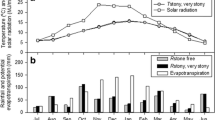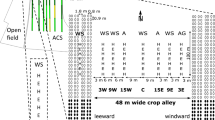Abstract
Based on the assumption that with unrestricted water availability, temperature will determine the response of sheltered crops, the effects of a Casuarina glauca Sieb. windbreak on the microclimate, water use and biological production of a lucerne crop were investigated. Degree-days (dd) were used to compute an index for the efficiency of the thermal effects of the shelter on a well- watered lucerne, under favourable (10 to 30 °C) and unfavourable (above 30 °C) temperature conditions. Water use efficiency was considered for two contrasting water regimes, with no water stress or with a large water deficit. In June, under favourable temperature and water availability conditions, temperature efficiency of the windbreak was 39 g m−2 dd−1 at a distance of three times the height of the trees compared to an exposed situation, and water use efficiency increased by 7.1 g mm−1. However, the sheltered conditions induced a decrease in above ground biomass production and water use efficiency when a highly restrictive water regime was applied. In July, daytime temperatures were disadvantageous to the lucerne, and even with a high degree of water availability, there were no significant differences between sheltered and unsheltered conditions. This research may help decision makers to manage windbreak systems by designing an appropriate irrigated area according to the shelter and choosing crops that will best benefit from sheltered conditions.
Similar content being viewed by others
References
Benzarti J (1989) Influence du brise-vent sur la production fourragère. In: Contribution à l’Etude des Brise-vent en Tunisie et en Région Méditerranéenne, Ann INRAT, No?Spéc, pp 138–145
Bierhuizen JF (1970) The effect of temperature on plant growth, development and yield. In: Slatyer RO (ed), Plant response of climatic factors, pp 89–98. Proc Uppsala Symp, UNESCO, Paris
Doorenboos J and Kassam AH (1980) Réponse des rendements à l’eau. Bull FAO d’Irrig et de Drain, No??nu33}
FAO (1969) Study tour on shelterbelts and windbreaks in the USSR. Part 1, Rep no?TA2561, FAO, Rome, 7–73
Fougerouze J (1968) L’effet brise-vent en climat tropical d’alizés. Agron Trop 11: 1137–1158
Frank AB and Willis WO (1978) Effect of winter and summer windbreaks on soil water gain and spring wheat yield. Soil Science Society of America Journal 42(6): 950–953
Grace J (1977) Plant response to wind. Monographs, 13, Acad Press, 204 pp
Guyot G (1967) Intérêt et dangers des brise-vent en agriculture. In: Pépin, Horti, Maraîch, 10è Coll sur les Plast en Agric Angers, pp 293–303
Guyot G, Delécolle R and Ben Salem M (1986) Brise-vent et rideaux abris avec référence particulière aux zones sèches. Conservation, Cahiers FAO, No??nu15}, 385 pp
Jensen AM (1983) Shelterbelts effects in tropical and temperate zones. Rep, July, 61 pp, IDRCMR80e, Ottawa
Jensen AM (1993) Shelterbelts versus screen plantations in the sahelian zone. In: Windbreaks and Agroforestry, pp 171–173. 4th Intern Symp, Hedeselskabet (Denmark), July 26–30
Jensen AM (1994) Examen des politiques, stratégies et programmes du secteur des énergies traditionnelles: évaluation des données sur les ressources ligneuses. Extr du rap princ, WB, Afr Techn Dep, AFTPS, Août
Kort J (1988) Benefits of windbreaks to field and forage crops. In: Brandle JR, Hintz DL and Sturrock JW (eds), Windbreak Technology, pp 165–190. Proceedings of an International Symposium on Windbreak Technology, Lincoln, Nebraska, June 23–27, 1986. Agric, Ecosys and Envir
Masle J, Doussinault G, Farquhar GD and Sun B (1989) Foliar stage in wheat correlates better to photothermal time than to thermal time. Plant, Cell and Envir 12: 235–247
Miller DR, Rosenberg NJ and Bagley WT (1973) Soybean water use in the shelter of a slatfence windbreak. Agric Meteor 14: 321–333
Monteith JL and Elston J (1992) Climatic constraints on crop production. In: Fowden L, Mansfield T and Stoddart J (eds), Plant Adaptation to Environmental Stress, Chap 3, pp 3–1. Chapman & Hall
Müller D and Nielsen J (1965) Production brute, pertes par respiration et production nette dans la forêt ombrophile tropicale. Extraits en fr. de la Det forstlige Forsogsvaesen i Denmark, Beretning nr. 225, vol. XXIX, pp 69–160
Rosenberg NJ, Blad BL and Verma SB (1983) Windbreaks and shelter effects. In: Microclimate: Biological Environment, pp 331–367. J. Wiley and Sons, 2nd edit
Van Eimern J, Karschon R, Razumova LA and Robertson GW (1964) Windbreaks and Shelterbelts. WMO, Techn Note, NLo??nu59}, 190pp
Van Eimern J (1966) Problems of shelter planning. In: Actes du colloque de Reading sur les methodes agroclimatologiques, pp 157–166. UNESCO, Paris
Author information
Authors and Affiliations
Rights and permissions
About this article
Cite this article
Benzarti, J. Temperature and water-use efficiency by lucerne (Medicago sativa) sheltered by a tree windbreak in Tunisia. Agroforestry Systems 43, 95–108 (1998). https://doi.org/10.1023/A:1026451206625
Issue Date:
DOI: https://doi.org/10.1023/A:1026451206625




